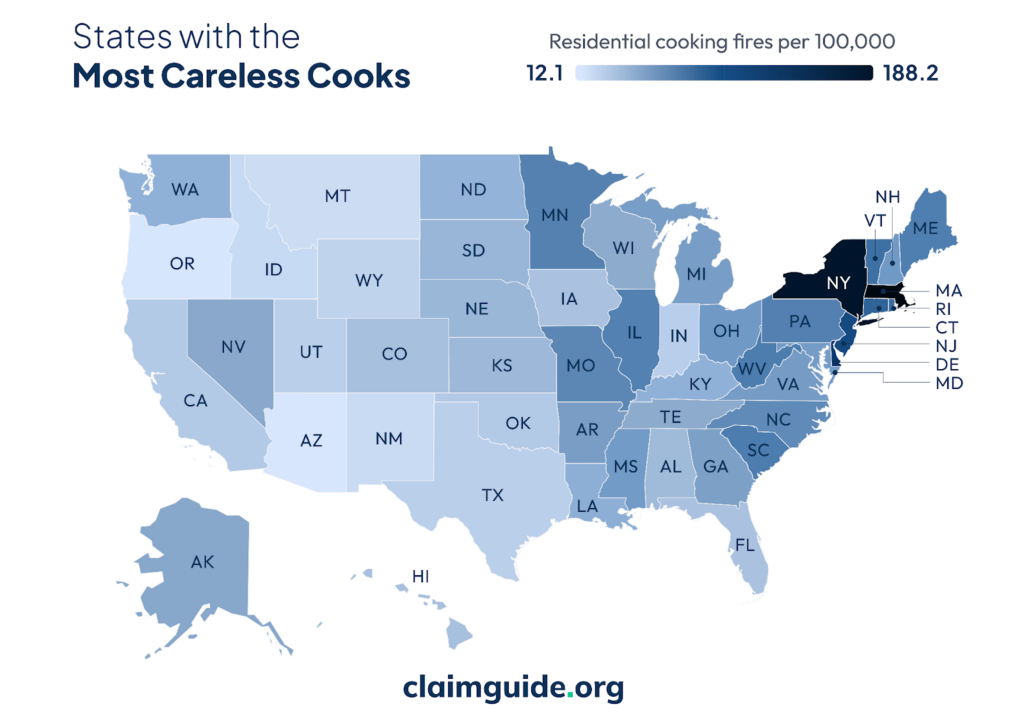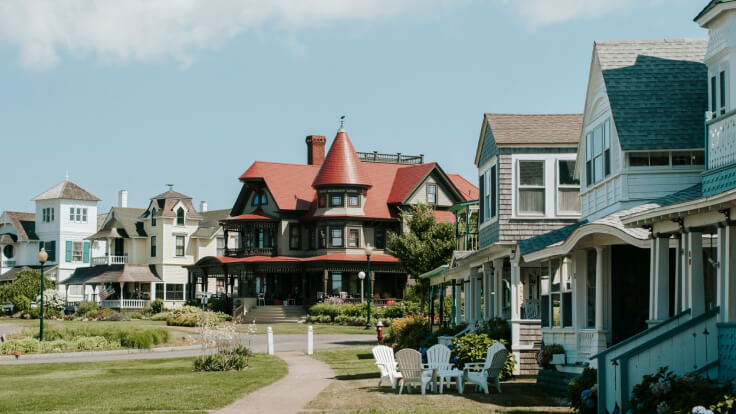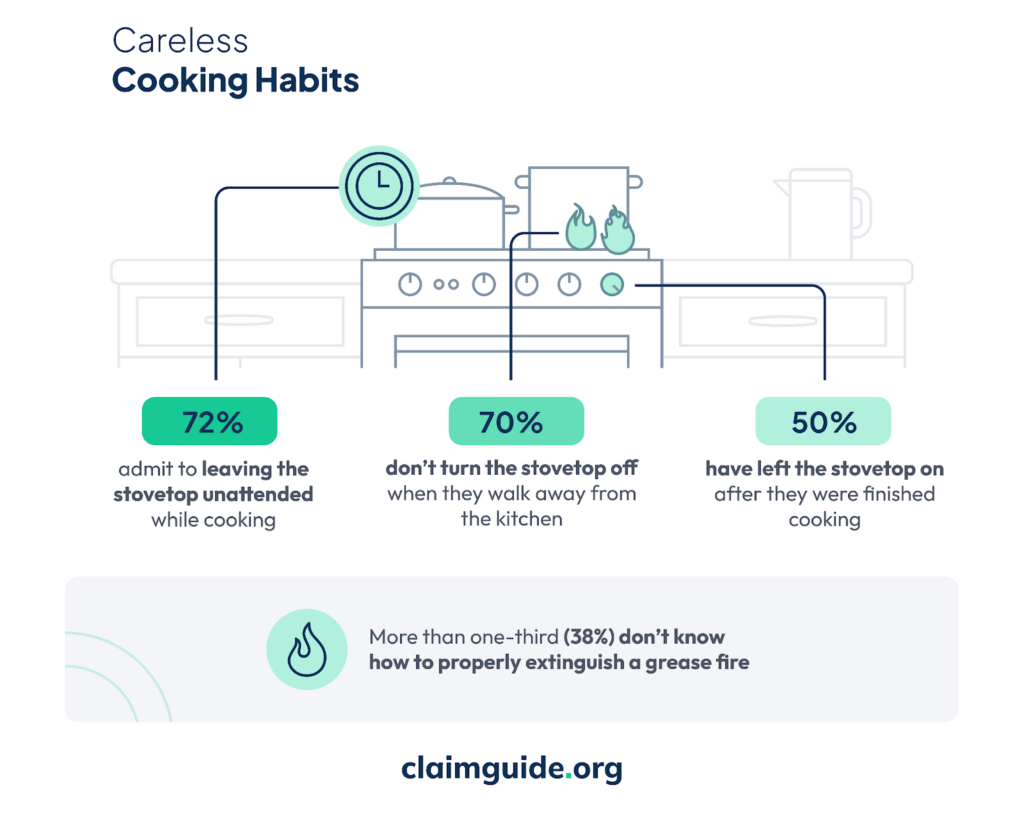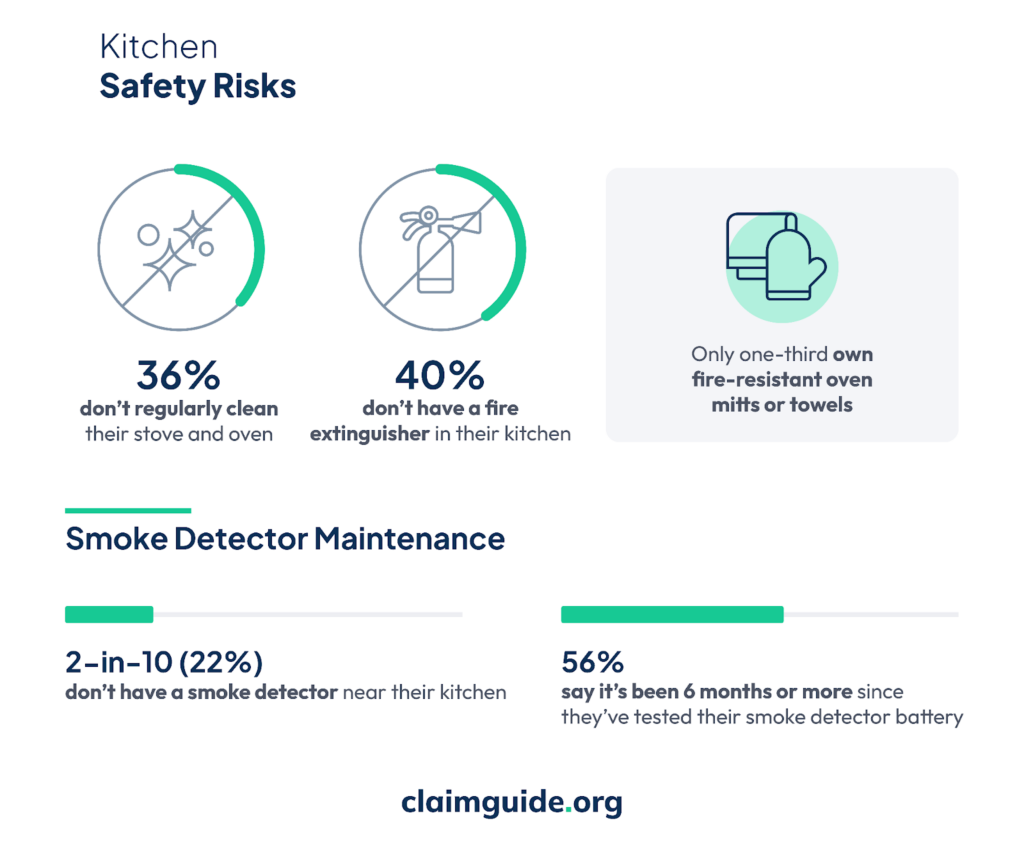Careless Cooks: Where are Kitchen Fires the Most Common?
Cooking is such an integral part of daily life that it’s easy to go on autopilot.
However, serious risks can happen when the stove is left on, the oven isn’t regularly cleaned, and proper equipment isn’t used.
One moment of carelessness can lead to a cooking catastrophe. Each year, residential cooking fires cause:
- 153 deaths
- 3,225 injuries
- Nearly half a billion dollars ($477 million) in damages
But which states are home to the most residential cooking fires?
To determine where America’s most “careless cooks” reside, we analyzed data from the National Fire Incident Reporting System (NFIRS) and the Federal Emergency Management Agency (FEMA) in all 50 states as well as the most populated counties nationwide.
In addition, we conducted a nationwide survey of 1,500 Americans to learn about their experiences with cooking accidents, injuries, and any safety mistakes they admit to making in the kitchen. We combined this data with other reporting from FEMA on rhythms of cooking hazards, including a breakdown of the greatest annual and daily periods of danger, to gain granular clarity on the reasons behind cooking fires.
Key highlights
- Massachusetts is home to the most cooking fires per capita, with an average of 13,137 cooking fires occurring each year (188.2 cooking fires per 100,000 residents).
- States in the Northeast claim 7 of the top 10 spots on our list, with New York (No. 2), Delaware (No. 3) and New Jersey (No. 4) closely following Massachusetts.
- Western states have the fewest cooking-related fires: Arizona, Oregon, Montana, New Mexico and Idaho each experience, on average, fewer than 17 cooking fires per 100,000 residents each year.
- Cooking fires claim an average of 153 lives per year, cause 3,225 injuries per year and are the cause of nearly half of all residential fires (48%).
- In our nationwide survey, 72% admitted to leaving the stove unattended, 50% say they’ve accidentally left the stovetop on after cooking, and 38% don’t know how to properly extinguish a grease fire.
States with the Most Careless Cooks

Our ranking of the most dangerous cooking regions in the country roughly follows this rule: states with high-density cities, multifamily apartments and cramped and high-traffic kitchens prove more susceptible to cooking fire incidents.
As an example, wide open Montana reports 15.8 cooking fires per 100,000 residents whereas compact Rhode Island reports 70.6 cooking fires per 100,000 residents.
In raw figures, New York state reports the most cooking fires per year (avg. 30,703), and Wyoming reports the fewest (avg. 112). Massachusetts, New York, and Delaware are the only states in the nation reporting over 100 cooking fires per 100,000 residents, with most states reporting fewer than 50 cooking fires per 100,000 residents.
Top 5 States with the Most Careless Cooks
#1. Massachusetts

- Percent of residential fires caused by cooking:
- 71.4%
- Average residential cooking fires per year:
- 13,137
- Residential cooking fires per 100,000:
- 188.2
With 188.2 cooking fires per 100,000 residents, Massachusetts tops our list of most careless cooks by a healthy margin. A whopping 71.4% of all house fires in Massachusetts are caused by cooking-related accidents, and the average number of residential fires per year sits at 13,137.
#2. New York

- Percent of residential fires caused by cooking:
- 70.8%
- Average residential cooking fires per year:
- 30,703
- Residential cooking fires per 100,000:
- 156.0
High density apartments and multi-family homes contribute to New York’s staggering statistics – with multiple cooks in the kitchen, it’s no wonder that 70.8% of all residential fires in the Empire State originate while cooking is underway. New Yorkers report 30,703 cooking fires per year – the most of any state in the nation – which averages out to 156 fires per 100,000 residents.
#3. Delaware

- Percent of residential fires caused by cooking:
- 55.4%
- Average residential cooking fires per year:
- 1,151
- Residential cooking fires per 100,000:
- 113.0
Possibly due to the al fresco traditions of clam bakes and oyster roasts, only 55.4% of all residential fires in Delaware start in the kitchen. Unfortunately, this still represents a large number of cooking fires: the state averages 113 cooking fires per 100,000 residents.
#4. New Jersey

- Percent of residential fires caused by cooking:
- 66.1%
- Average residential cooking fires per year:
- 8,827
- Residential cooking fires per 100,000:
- 95.3
With its mixture of dense cities and tomato farms, there’s almost always a pot of marinara simmering on the stove in New Jersey. Unfortunately, all those unattended stoves mean cooking fires are common in the Garden State. 66.1% of all house fires start in the kitchen, leading to 8,827 cooking-related fires in an average year.
#5. Washington, D.C.

- Percent of residential fires caused by cooking:
- 57.6%
- Average residential cooking fires per year:
- 549
- Residential cooking fires per 100,000:
- 81.7
A cultural melting pot, D.C. residents cook to express their roots and escape the price tags that come with the city’s robust power dining scene. But all the home cooking comes with risks: inside the D.C. metro, there’s more than 1 cooking fire per day (549 avg. per annum), and over half (57.6%) of all residential fires start in the kitchen.
Cost of Careless Cooking

Careless cooking comes at a steep price. In an average year, 185,040 cooking fires cause 153 casualties, 3,225 injuries and $477,980,000 in property loss. It is the most common cause of residential fires in America, with 48% of all fires originating from cooking-related activities.
Extra vigilance should be applied under certain conditions – cooking fires are most likely to occur in multifamily residential buildings (46.3%) and one- and two-family residential homes (43.9%) between the hours of 4 and 9 p.m. (40%) in the winter months, with November being the most dangerous month for cooking fires.
Careless Cooking Habits

Mindless mistakes are part and parcel of routine cooking – 72% of home cooks have left an element unattended, 70% admit to leaving the stovetop on even if they exit the kitchen entirely, and 50% of home cooks say they have left the stovetop on after they were finished cooking.
With open elements and organic materials, such as cooking oils, causing the most damage, understanding how to handle food-fueled fires is a critical containment measure, yet over 1-in-3 respondents (38%) confessed that they don’t know how to properly extinguish a grease fire.
Kitchen Safety Risks

Avoiding kitchen fires starts long before cooking begins – a clean workspace, proper cooking equipment and appropriate fire safety measures go a long way towards reducing cooking fire damage.
According to our survey, only 1 in 3 cooks own fire-resistant oven mitts or towels, 40% don’t have a fire extinguisher in their kitchen, and 36% don’t clean their stove or oven regularly. If a fire does break out, 2 in 10 home cooks don’t have a smoke detector near their kitchen, and 56% are overdue for a smoke detector test.
Top 5 Counties with the Most Careless Cooks
Along with analyzing states with the most careless cook, we also conducted a county-level analysis of annual residential cooking fires. Our analysis covers the 100 most populated counties across the country and ranks each based on cooking fires per 100,000 residents.
#1. Suffolk County, Massachusetts
- Percent of residential fires caused by cooking:
- 85.8%
- Average residential cooking fires per year:
- 4,022
- Residential cooking fires per 100,000:
- 524.8
Once again, the Northeast dominates the list of counties with the most cooking fires. Two Massachusetts counties, including Suffolk County, rank within the top 5. Situated at the core of the Boston metropolitan area, Suffolk County takes the lead, with nearly 86% of residential fires caused by cooking. This results in more than 4,000 cooking-related fires per year in the county.
#2. New York County, New York
- Percent of residential fires caused by cooking:
- 71.9%
- Average residential cooking fires per year:
- 3,848
- Residential cooking fires per 100,000:
- 241.1
Taking the No. 2 spot is New York County, which is home to one of New York City’s most popular boroughs: Manhattan. This New York City borough experiences 3,848 cooking fires per year, or 241.1 per 100,000 residents.
#3. Worcester County, Massachusetts
- Percent of residential fires caused by cooking:
- 67.7%
- Average residential cooking fires per year:
- 1,878
- Residential cooking fires per 100,000:
- 217.7
We travel back to Massachusetts to find the No. 3 county on our list. Located roughly 40 miles west of Boston, Worcester County experiences more than 1,800 cooking-related fires per year, or 217.7 per 100,000 residents.
#4. Westchester County, New York
- Percent of residential fires caused by cooking:
- 76%
- Average residential cooking fires per year:
- 2,110
- Residential cooking fires per 100,000:
- 213.1
In this historic Hudson Valley county, more than three-quarters of residential fires are caused by cooking. Overall, Westchester County residents experience 2,110 cooking fires per year, or 213.1 per 100,000 residents.
#5. Hudson County, New Jersey
- Percent of residential fires caused by cooking:
- 74.3%
- Average residential cooking fires per year:
- 1,235
- Residential cooking fires per 100,000:
- 175.7
Located west of the lower Hudson River, more than 700,000 residents call Hudson County home, and over 1,200 experience a cooking fire each year. Overall, 74% of residential fires in Hudson County are caused by cooking.
Studying cooking fires carefully can help avoid problems in the future and keep your home safe. Knowing that 71.3% of kitchen fires start at the stove may help you remember to watch the stove instead of leaving your simmering soup unattended.
You can take steps now to reduce your risk – make sure your smoke detectors are functioning, your oven is clean, and you know how to contend with a cooking fire incident. Preparation is the best line of defense against accidents that could happen to anyone.
Does Homeowners Insurance Cover Fire Damage?
What type of damages are covered by a homeowners insurance policy when a fire occurs? Thankfully, both your home as well as belongings are covered up to the policy limits, according to ClaimGuide.org insurance specialist, Gerard Reczek.
“Homeowners insurance policies provide coverage in the event of fire to both the building and contents up to the policy limits for each,” said Reczek, an Excess and Surplus Lines Insurance Specialist. “Damage from water used to suppress the fire, smoke, and loss of use are standard coverages afforded by a homeowner’s policy. The loss of use trigger will help with the cost for replacement housing while the damaged property is repaired or replaced.”
It’s always a good idea to be aware of your policy coverage to understand whether your home as well as personal items such as appliances and furniture are protected under your policy. But keep in mind that depreciation of your home’s contents will be considered if the replacement cost extension is not provided in your policy.
Along with understanding your policy, studying cooking fires carefully can help avoid problems in the future and keep your home safe. Knowing that 71.3% of kitchen fires start at the stove may help you remember to watch the stove instead of leaving your simmering soup unattended.
When it comes to kitchen fires, you can take steps now to reduce your risk – make sure your smoke detectors are functioning, your oven is clean, and you know how to contend with a cooking fire incident. Preparation is the best line of defense against accidents that could happen to anyone.
Methodology
To determine our ranking, we analyzed fire incidents for all 50 states and Washington, D.C. via the National Fire Incident Reporting System (NFIRS) and the Federal Emergency Management Agency (FEMA) reporting. We also analyzed county-level fire incidents from the 100 most populated counties in the country. Our study spans data from the 4 most recently reported years in order to arrive at an average number of cooking-related residential fires across the U.S. According to NFIRS, state and local reporting policies and incidents vary based on location.
In January 2024, we conducted a nationwide survey of 1,500 Americans to gain insights into the origins of cooking-related fires. Respondents were asked about their daily cooking habits, kitchen equipment, and knowledge of how to respond to cooking-related crises. 55% of respondents were female, 42% were male and 3% were non-binary/non-conforming. The average age of respondents was 41.
Sources: National Fire Incident Reporting System (NFIRS), Federal Emergency Management Agency (FEMA), U.S. Fire Administration (USFA), United States Census Bureau American Community Survey
Fair Use: Feel free to use this data and research with proper attribution linking to this study.
Media Inquiries: For media inquiries, contact [email protected]